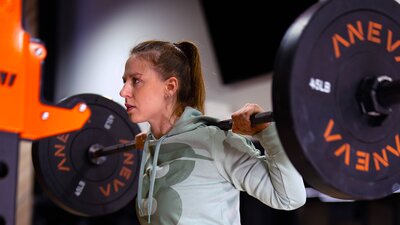Many exercises are available for the glutes, making it difficult to determine the most effective. Let’s help you understand which glute exercises are the most effective for building strength and muscle mass by identifying exercises that:
Train anatomical functions of the glutes
Progressively overload the glutes
Promote high muscle activation
Anatomical Functions of the Glutes
Before creating a top-five list of exercises for any muscle, it is important to understand the muscle's functions so that we can train it effectively. The gluteus maximus has four primary functions:
Hip extension
Hip abduction
Hip external rotation
Posterior pelvic tilt
Strength and Hypertrophy Focus
To build strength and hypertrophy, focus on exercises that allow for progressive overload. Research suggests training multiple sets that end at or near failure (10). Prioritize exercises that elicit muscle EMG activation near maximum voluntary contraction. Avoid prioritizing bodyweight and band exercises for these goals.
Top Five Exercises
This list will prioritize exercises that meet the following criteria:
Train an anatomical function of the glutes
Have been shown to elicit high muscle EMG activation
Progressive overload can be applied
#1 Hip Thrust
The hip thrust has been found to induce high amounts of glute activation (8). It is primarily a hip extension exercise with a high potential for a posterior pelvic tilt, one of the four functions of the glutes.
The posterior pelvic tilt is an important part of the lockout, or end, of the hip thrust. Other lower body exercises require a lockout, but the hip thrust arguably provides the highest potential for a solid lockout.
The hip thrust is also an exercise that allows for nearly unlimited loading due to the high loading capacity of barbells and hip thrust machines. Research shows the hip thrust reaches very high amounts of glute activation, similar to back squats (1).
#2 Barbell Back Squat
The barbell back squat is a knee-dominant exercise that achieves high amounts of hip and knee extensor activation (4). Some research shows that squats are superior to hip thrusts and deadlifts at activating both the glutes and the quads (1).
Compared to other squatting variations, the low bar back squat has the highest loading potential and glute activation (5). This is due to kinematics and loading position, which maximally leverage the strong posterior chain by reducing the lever arm of the spine.
The barbell back squat can be loaded to high levels. If a rack or barbell is not available, other squat machines such as the hack squat, belt squat, etc can be utilized, but the emphasis on the glutes will be different.
#3 Conventional Deadlift
The deadlift is a hip-dominant exercise that reaches high hip extension joint moments (forces), working less quads and more hamstrings than squats (Martin, 2020). It allows for progressive overload and has been shown to elicit high levels of glute activation (6). Other variations like the Romanian deadlift or hex bar are also viable options, as they can be progressively loaded.
#4 Hip Abduction Machine
The hip abduction machine is an exercise that trains the hips in abduction, which is moving the legs away from the body. As a weight stack machine, it allows for progressive overload. One study found the hip abduction machine elicited the greatest gluteus medius activation and the least tensor fascia latae activation compared to other abduction exercises (3, Paz, 2022).
If a hip abduction machine is unavailable, the hip abductors, like the gluteus medius, can also be trained isometrically through single-leg exercises, such as the single-leg Romanian deadlift.
#5 Glute-Focused Bulgarian Split Squat
The Bulgarian split squat is a hip-dominant exercise focusing on hip extension while minimizing knee extension, compared to back squats (7). Research has demonstrated that the Bulgarian split squat promotes greater recruitment of the glutes compared to back squats (7).
To make a Bulgarian split squat glute-focused, maintain the weight-bearing knee over the ankle throughout the lift by keeping the tibia vertical. Then lean forward more at the torso until you feel your glutes carrying the tension.
Outro
As of 2023, a pre-peer-reviewed study found that hip thrust and squats elicit similar gluteal hypertrophy and similar strength transfer to the deadlift (9). This means the hip thrust, squat, and deadlift are all similarly effective at glute strengthening and hypertrophy. However, some studies show slight favor for one over the other for glute hypertrophy (Anderson, 2018; 1, 2)).
By recognizing the crucial elements of each exercise, such as the capacity for progressive overload or emphasis on distinct anatomical functions, we've identified five effective glute exercises for strength and hypertrophy for you to add to your routine.
#6 Honorable Mention - Loaded Hip 90-90
The list above did not include an exercise that trains the glutes in significant external rotation. The loaded hip 90-90 trains the glutes with significant external rotation. It can be loaded by holding a dumbbell “goblet squat” style, a barbell on the back, or a zercher carry. With the hips in the 90-90 position, the leg in front places the hip in external rotation. During the concentric upward phase of the exercise, the front glute extends the hip and creates an external rotation force into the floor.
Sources
Barbalho M, Coswig V, Souza D, Serrão JC, Hebling Campos M, Gentil P. Back Squat vs. Hip Thrust Resistance-training Programs in Well-trained Women. Int J Sports Med. 2020 May;41(5):306-310. doi: 10.1055/a-1082-1126. Epub 2020 Jan 23. PMID: 31975359.
Contreras B, Vigotsky AD, Schoenfeld BJ, Beardsley C, Cronin J. A Comparison of Gluteus Maximus, Biceps Femoris, and Vastus Lateralis Electromyographic Activity in the Back Squat and Barbell Hip Thrust Exercises. J Appl Biomech. 2015 Dec;31(6):452-8. doi: 10.1123/jab.2014-0301. Epub 2015 Jul 24. PMID: 26214739.
de Almeida Paz I, Frigotto MF, Cardoso CA, Rabello R, Rodrigues R. Hip abduction machine is better than free weights to target the gluteus medius while minimizing tensor fascia latae activation. J Bodyw Mov Ther. 2022 Apr;30:160-167. doi: 10.1016/j.jbmt.2022.01.001. Epub 2022 Jan 19. PMID: 35500965.
Delgado J, Drinkwater EJ, Banyard HG, Haff GG, Nosaka K. Comparison Between Back Squat, Romanian Deadlift, and Barbell Hip Thrust for Leg and Hip Muscle Activities During Hip Extension. J Strength Cond Res. 2019 Oct;33(10):2595-2601. doi: 10.1519/JSC.0000000000003290. PMID: 31356511.
Glassbrook DJ, Brown SR, Helms ER, Duncan S, Storey AG. The High-Bar and Low-Bar Back-Squats: A Biomechanical Analysis. J Strength Cond Res. 2019 Jul;33 Suppl 1:S1-S18. doi: 10.1519/JSC.0000000000001836. PMID: 28195975.
Lee S, Schultz J, Timgren J, Staelgraeve K, Miller M, Liu Y. An electromyographic and kinetic comparison of conventional and Romanian deadlifts. J Exerc Sci Fit. 2018 Dec;16(3):87-93. doi: 10.1016/j.jesf.2018.08.001. Epub 2018 Aug 11. PMID: 30662500; PMCID: PMC6323186.
Mackey ER, Riemann BL. Biomechanical Differences Between the Bulgarian Split-Squat and Back Squat. Int J Exerc Sci. 2021 Apr 1;14(1):533-543. PMID: 34055144; PMCID: PMC8136570.
Neto WK, Vieira TL, Gama EF. Barbell Hip Thrust, Muscular Activation and Performance: A Systematic Review. J Sports Sci Med. 2019 Jun 1;18(2):198-206. PMID: 31191088; PMCID: PMC6544005.
Plotkin DL, Rodas MA, Vigotsky AD, McIntosh MC, Breeze E, Ubrik R, Robitzsch C, Agyin-Birikorang A, Mattingly ML, Michel JM, Kontos NJ, Frugé AD, Wilburn CM, Weimar WH, Bashir A, Beyers RJ, Henselmans M, Contreras BM, Roberts MD. Hip thrust and back squat training elicit similar gluteus muscle hypertrophy and transfer similarly to the deadlift. bioRxiv [Preprint]. 2023 Jul 5:2023.06.21.545949. doi: 10.1101/2023.06.21.545949. Update in: Front Physiol. 2023 Oct 09;14:1279170. PMID: 37461495; PMCID: PMC10349977.
Ruple BA, Plotkin DL, Smith MA, Godwin JS, Sexton CL, McIntosh MC, Kontos NJ, Beausejour JP, Pagan JI, Rodriguez JP, Sheldon D, Knowles KS, Libardi CA, Young KC, Stock MS, Roberts MD. The effects of resistance training to near failure on strength, hypertrophy, and motor unit adaptations in previously trained adults. Physiol Rep. 2023 May;11(9):e15679. doi: 10.14814/phy2.15679. PMID: 37144554; PMCID: PMC10161210.

